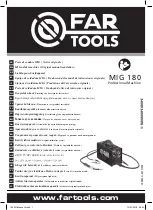
- 89 -
PATON
StandardMIG
DC MMA/TIG/MIG/MAG
5.7 END-OF-WELDING VOLTAGE/SPEED DECAY FUNCTION
This function is designed for the smooth welding of a crater formed in the weld pool by
the electromagnetic arc, which is then a source of defects in the weld seam. The signal to
start the function is to release the button on the torch at the end of the welding process.
The torch must be stopped and the dimple (that is the crater) in the weld must be welded
with decreasing voltage.
By default, both are set to 0.1 sec, i.e. actually in off state. This value can be changed at
your own discretion, see section 6.1 for the procedure.
WARNING!
When welding steel wire, the decay time [t.dn] at the source should be
either equal to or slightly greater than the wire feeder. When welding aluminum wire, the
decay time [t.dn] at the source should be less (-0.3...-0.7 sec.) than at the wire feeder.
5.8 PULSED VOLTAGE WELDING FUNCTION
This function is designed to facilitate the control of the welding process in spatial
positions other than bottom and in the welding of non-ferrous metals. The effect is
directed to the mixing of the molten weld metal and to the drip transfer into the weld pool,
and this in turn affects the stability of the weld formation and the welding process. In other
words, this process to some extent replaces the movements of the welder's hand, which is
especially important in hard-to-reach places. The shape and quality of the weld formation
depends on the correct setting, which reduces the likelihood of pores and reduces the
granularity of the structure, and this increases the strength of the weld.
To implement this function, three parameters must be set in the unit: pulsing power
[Po.P], pulsing frequency [Fr.P] and pulse/pause ratio (or "duty ratio") [dut]. By default, the
pulsing power as a key parameter is in "OFF" position, i.e. the function is disabled, and the
pulsing frequency and "duty ratio" are at the most common values of 20 Hz and 50%
respectively. To enable the function, it is sufficient to set the pulsing power greater than
zero. This parameter is set as a percentage of the main welding current set.
Example: When welding with 0.8 mm wire, with a wire feed speed set to 5.5 m/min,
main welding voltage set to 18V and pulsing power set to 20%, with a pulse frequency of 20
Hz and a "duty ratio" of 50% by default.
Result: The current will pulse from 14.4V to 21.6V with a frequency of 20 Hz. The pulses
will have the same shape in amplitude and time.
The "duty ratio" parameter is set to 50% by default. If you change this parameter from
50%, the asymmetry between the current pulse time and the current "pause" time is
entered:
By default
"duty ratio" 50%
"duty ratio" 20%
"duty ratio" 70%













































